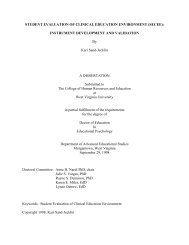The Use of Native Plants for Revegetation along West Virginia ...
The Use of Native Plants for Revegetation along West Virginia ...
The Use of Native Plants for Revegetation along West Virginia ...
Create successful ePaper yourself
Turn your PDF publications into a flip-book with our unique Google optimized e-Paper software.
1. Introduction<br />
Due to the mountainous nature <strong>of</strong> <strong>West</strong> <strong>Virginia</strong>, the process <strong>of</strong> highway construction <strong>of</strong>ten<br />
involves the blasting and removal <strong>of</strong> large amounts <strong>of</strong> geologic material from one area to be used<br />
as fill <strong>for</strong> other areas. <strong>The</strong>se “cut and fill” areas are highly disturbed and easily eroded.<br />
<strong>The</strong>re<strong>for</strong>e, a fast and effective ground cover is required to control erosion. <strong>The</strong> current method is<br />
to provide a vegetative cover that is fast-growing and easy-to-establish. However, owing to their<br />
known ability to control erosion, ease <strong>of</strong> establishment, and cost-effectiveness, nearly all species<br />
used <strong>for</strong> this control are non-native and/or invasive (Skousen and Fortney, 2003). Once<br />
established, the non-natives can persist indefinitely and can use vehicular traffic as a vector to<br />
expand their range. Thus, the use <strong>of</strong> these species is <strong>of</strong> special concern to <strong>West</strong> <strong>Virginia</strong> and the<br />
environment.<br />
<strong>Native</strong> species can be defined as, with respect to a particular ecosystem, those plants that<br />
historically occurred or currently occur in an ecosystem without having been originally<br />
introduced. Invasive species are those non-natives that cause, or are likely to cause, harm to the<br />
economy, environment, or human health (Executive Order 13112, 1999). However, this<br />
definition <strong>for</strong> invasives leaves out what is <strong>of</strong>ten a key aspect <strong>of</strong> their behavior: proliferation and<br />
spread. To be sure, not all non-natives are invasive, nor are all invasives non-native.<br />
Invasive plants cause an estimated $137 billion a year in environmental damage. Over 40%<br />
<strong>of</strong> the species listed as threatened or endangered under the Endangered Species Act are there<br />
primarily because <strong>of</strong> competition from non-native species (Nature Conservancy, 2003). Former<br />
president Bill Clinton signed the Executive Orders on Invasive Species (EO 13112) and<br />
Greening the Government through Leadership in Environmental Management (EO 13148) in<br />
1999 and 2000, respectively. <strong>The</strong>se orders were designed to prevent the introduction <strong>of</strong> invasive<br />
species, control their spread, and implement cost-effective, environmentally sound landscaping<br />
practices. This is to be done by both using existing programs to limit the introduction and spread<br />
<strong>of</strong> invasives, as well as creating new programs to promote the use <strong>of</strong> native plant species.<br />
However, the use <strong>of</strong> native plants on roadsides has two major problems. First, these are<br />
highly disturbed and rigorous sites which tend to inhibit the successful establishment <strong>of</strong> the<br />
competitively disadvantaged natives. Second, the seeds <strong>of</strong> native plants are <strong>of</strong>ten unavailable in<br />
large quantities and/or are too expensive to be cost effective <strong>for</strong> seeding large areas.<br />
1












